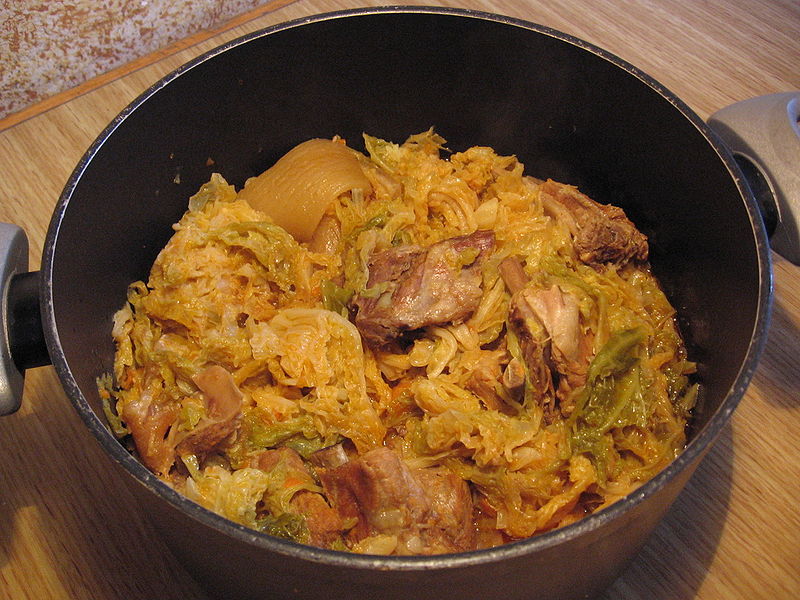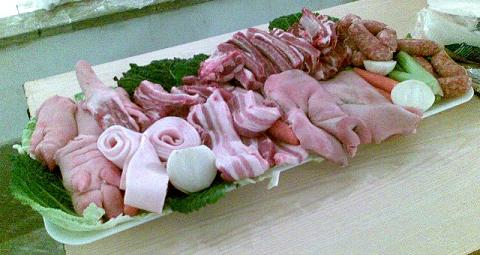In a Land of Plenty, Twins Teach Simplicity
BOLOGNA is a city that lives on its stomach. True, it has Italy's leading university. It fields a pretty good soccer team, too. But Bologna's real study and its true sport is food. Its markets are unrivaled in Europe. The legendary Tamburini food shop is paradise on earth. And then there are the Simili sisters.
Deep in a courtyard off the Via San Felice, Margherita and Valeria Simili do what they have been doing all their lives -- they cook and bake. As girls, helping out in the family bakery, they made bread, pasta and cakes for their customers. Later, they cooked for their families. And for the last 13 years, they have run a little cooking school, founded with the help of Marcella Hazan, one of their biggest fans, that is one of the city's most valuable hidden assets.
Around 3 P.M. on the Via San Felice, five days a week, you can see pedestrians turning off the street and into the courtyard at No. 116. At the far end of the courtyard, at Staircase G, they enter what looks like an apartment but turns out to be a large kitchen, where the sisters, already revved up for a full afternoon's workout, take coats, collect the one-day tuition fee of 120,000 lire (about $65), offer coffee and aprons, and manage to generate an atmosphere of cheerful bustle, although nothing in particular is actually happening.
Today, the lesson is an unusual one: la cucina rapida, or quick and easy cooking. Yesterday, it was pasta. Tomorrow, it will be bread, and the day after that, desserts. Most of their food comes straight from the heart of Emilia-Romagna, a rich gastronomic region where the tomato is a tourist and fish is foreign, but butter, milk, cheese and pasta achieve dizzying heights. Parmigiano-Reggiano, prosciutto, mortadella, culatello, golden tortellini filled with meat, cheese and vegetables -- the region's roster of culinary all-stars goes on and on.
For students, the Simili school is a chance to experience Italian home cooking at the highest level, passed along by two women -- 63-year-old twins -- who make no special claims for what they do. ''We like very simple cooking, and although we do have a food processor, we almost always work only by hand,'' Margherita Simili said. ''You feel more joyful that way, and you understand better what you are making.''
At the beginning of the lesson, she steps to the head of a long work table and commands attention with a crisp ''Bimbi!'' (''Kids''), one of three salutations she will use to restore order over the next four hours. Again and again, the student body -- a dozen Italian women and a lone American man -- will snap to attention at the sound of ''Bimbi,'' ''Bambini'' (''Kiddies'') and ''Ragazzi'' (''Guys''), the signals that important instructions are about to follow. (Classes are in Italian, but both sisters speak English and, with well-timed interruptions, translate the goings-on.)
The menu looks ambitious. It begins with prosciutto slices that are spread with a paste of mustard, Parmigiano-Reggiano and, unbelievably, Philadelphia cream cheese, and then wrapped around pear slices. It concludes, eight dishes later, with a whisky-soaked cake made with chocolate, peaches, crushed amaretti and a rich local ricotta that is half sheep's milk, half cow's milk. Motivation runs high, since the day's work will later be consumed as dinner.
Margherita operates at a high energy level, racing from table to stove, yanking volunteers from the group, chaffing them good naturedly when they fumble or hesitate, and fielding questions along the way.
Valeria, who does the food shopping, stays on the sidelines, putting supplies on the table, whisking away used plates and, at selected moments that are milked to the utmost for dramatic impact, stepping up to the head of the table to taste her sister's work and correct it with salt and pepper.
The salt routine goes over big with the group. Margherita stands aside, a stirring spoon held aloft, as her sister slowly tastes, eyes turned toward the ceiling. A hush falls over the group. Long seconds pass. Valeria suddenly reaches for the salt pile and tosses several pinches in the bowl with a flourish.
Valeria lets her sister do most of the talking. She knows that a silently administered dash of salt makes for better theater. It also sets up her coup de grace, the moment when she tastes, starts to reach for the salt -- and then declares the mushroom stuffing to be perfect as is. In mock indignation, she turns to the class and says, ''I don't always add salt, you know -- only when it's needed, and in this case, the Parmesan gives us all the salt we need.''
So it goes, through the unexpectedly delicious polline di fagioli (cold bean balls with a garlic and parsley sauce), a sneakily clever baked pasta dish devised to keep the top of the stove clear, veal balls in port sauce, a pea and cheese mold, beef and vegetable brochettes, and baked stuffed mushroom caps. As the afternoon turns into evening, a communal table is set, the day's work is set out, the sisters open a lightly fizzy bottle of white wine from the hills around Bologna and, without further ado, a dozen Italians get ready to do what they do best: eat.
The Similis were born in Bologna, perhaps 500 feet from their kitchen, which is not far from their present apartment. Their father, Armando, owned one of the city's most celebrated bakeries, the Panificio Simili Armando, right on the Via San Felice, at No. 67. At the age of 12, his daughters began working behind the counter. When the orders piled up, they would go to the back of the bakery and help make tortellini, tortelli and other pastas, as well as the distinctive Bolognese bread, with its shiny, smooth crust and soft, snow-white interior.
''Our mother was a very good cook, very traditional,'' Margherita said. ''We didn't know anything about Mediterranean cooking in those days, for example, because we didn't travel, but we did know the cooking of Emilia-Romagna, which is very good. We have few traditions for second courses, and no fish, but the pasta is the best in Italy.''
The Simili philosophy is pure Italian: seek out perfect ingredients and then try not to get in their way. ''I try to be simple and natural,'' she said. ''But the simpler the dish, the more difficult it is to reproduce. I don't really have a feel for high cuisine, and I don't like it too much.''
One pasta lesson, for example, covers local forms like tortelli, tortellini, cappelletti, tagliatelle, lasagne and cannelloni. Another covers typical pastas from all over Italy. In other lessons, students learn about the meat broths and the meat sauces that Bologna made famous.
In the mid-1970's, when Marcella and Victor Hazan were traveling all over Italy collecting information for their second cookbook, they sought out the Simili bakery and struck up an acquaintance with the sisters that developed into a professional collaboration. When the Hazans opened a cooking school in Bologna, they hired Valeria as an assistant. Later, they hired Margherita to teach baking and to lead students on field trips in the area. At about this time, their father sold the business, and the sisters opened their own bakery. But the hard work was taking a toll.
''Margherita came to us and said, 'I don't think I can stand the schedule, I'd like to teach,' '' Mr. Hazan said. ''Marcella told them she thought it was a great idea.'' Mrs. Hazan not only encouraged the sisters to set up a school but gave them the equipment from her kitchen when she closed down her school in Bologna and relocated to Venice.
Gradually, the little school took root, attracting a varied clientele. The students in the cucina rapida course included a very elderly woman from the neighborhood, a tourist or two passing through, and young local women in search of tips or simply a fun afternoon. The sisters have given courses for children, and to draw a broader clientele, they have ventured outside their usual boundaries to offer instruction on, say, Tuscan cuisine or fish cookery, often relying on outside experts.
''We get all kinds,'' Valeria said. ''We get shopkeepers, postal workers, rich people. There are people who have told us that taking this course is better than analysis. It's a lot cheaper, and they feel better.''
CHIFFERI PILAF
Adapted from Margherita and Valeria Simili
Time: 30 minutes
1 pound zucchini
2 green tomatoes or 2 to 3 tomatillos, husked
4 tablespoons butter
2 garlic cloves, peeled and crushed
1 pound chifferi or other small ridged pasta, such as pennette
3 cups chicken broth
1 cup milk
Salt and freshly ground black pepper
7 to 10 tablespoons freshly grated Parmigiano-Reggiano
8 to 10 fresh basil leaves.
1. Preheat oven to 325 degrees. Using a mandoline, cut zucchini into julienne. Using a sharp knife, julienne tomatoes or tomatillos. Set aside.
2. In a large casserole over medium-low heat, melt 2 tablespoons butter, and add garlic. Saute until softened and beginning to brown, about 3 minutes. Add zucchini and tomatoes or tomatillos, and gently toss until warmed through.
3. Add pasta, chicken broth, milk, and salt and pepper to taste. Stir well, cover and bake 4 minutes. Remove from oven and stir well. Cover pan, return to oven and continue to bake until pasta is al dente, about 5 to 7 minutes.
4. Remove pan from oven and discard the garlic cloves. Add remaining 2 tablespoons butter, cheese and basil. Pour into a warm bowl, and serve immediately.
Yield: 4 to 6 servings.
VEAL MEATBALLS IN PORT SAUCE
Adapted from Margherita and Valeria Simili
Time: 30 minutes
1 14 1/2-ounce can chicken broth
1 14 1/2-ounce can beef broth
1/2 cup port
2 1/2 tablespoons butter
2 1/2 tablespoons flour
Salt and freshly ground black pepper
Pinch of sugar, optional
1 pound ground veal
2 large egg yolks
1/2 cup dry bread crumbs
4 to 5 tablespoons finely grated Parmigiano-Reggiano.
1. In a bowl or large measuring cup, combine chicken and beef broth. In a small saucepan over medium heat, combine 3 cups broth mixture and port. Bring to a boil, then turn off heat and keep warm.
2. In a large saucepan or casserole over medium-low heat, melt butter, then stir in flour until smooth. Add broth and port mixture, salt, pepper and sugar to taste. Simmer until slightly thickened and smooth, about 4 to 5 minutes. Keep warm.
3. In bowl of a food processor, combine veal, egg yolks, bread crumbs, Parmigiano-Reggiano and salt to taste. Add 4 to 5 tablespoons of remaining broth mixture. Process 1 minute to blend well. Remove blade, and shape mixture into about 30 balls, Approximately 1 1 / 2 inches in diameter.
4. Bring sauce to a simmer, add meatballs and simmer until firm and cooked through, about 4 to 6 minutes. Serve with the sauce.

